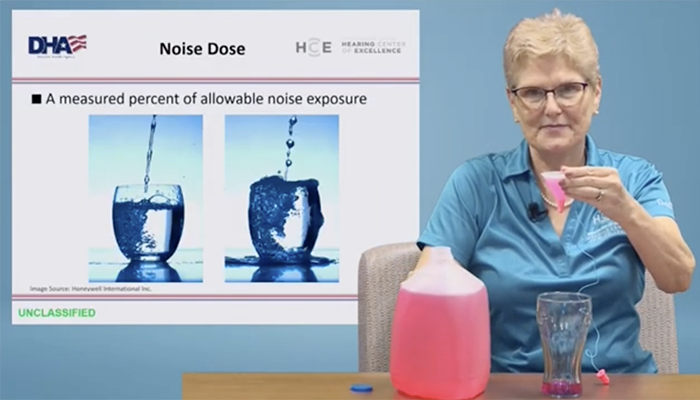Audiologist Demonstrates Importance of Hearing Conservation
By Jacqueline Gase
NMHM Public Affairs Coordinator

Caption: Dr.Theresa Schulz, chief of prevention and surveillance at the DoD Hearing Center of Excellence, demonstrates the proper use of a foam earplug. (NMHM photo)
Almost every service member will be exposed to hazardous noise levels at some point in their career. Hearing loss is a significant health and readiness issue for the U.S. military since afflicted personnel exposed to hazardous noise are more likely to suffer additional hearing damage, according to research studies.
Learning about the ear and how hearing damage can occur was the featured topic of the October Medical Museum Science Café held virtually by the National Museum of Health and Medicine in Silver Spring, Maryland.
Theresa Schulz, Ph.D., from the Department of Defense Hearing Center of Excellence, a division of the Defense Health Agency Research and Development Directorate, spoke during the virtual presentation, held during National Audiology Awareness Month in October.
Schulz, an audiologist, highlighted how the ear functions, how hearing damage can occur when subjected to hazardous noise over time or from a one-time explosion, and the importance of hearing protection to maintain hearing health.
To visually show how the ear functions, Schulz presented three demonstrations.
The first demonstration explained noise dose. According to Schulz, each individual has a particular limit of allowable noise exposure before being susceptible to hearing loss. Noise dose is this measured limit. Using water and two differently sized glasses to represent a "tough ear" and a "tender ear," Schulz showed how with a higher noise level, exposure time must be shorter.
"According to the Occupational Safety and Health Administration, for an eight hour exposure, the maximum permissible sound level is 90dB (decibels)," said Schulz. At the 100 percent dose where an individual is at risk for hearing loss, the water spilled over the glass representing damage to our auditory system.
Schulz used pipe cleaners to illustrate how the auditory system processes sound and noise.
"Sound waves enter the ear canal and the acoustic energy is modified. The modified acoustic energy causes the eardrum to vibrate. Behind the eardrum, the three smallest bones in the human body amplify that energy by up to 27 times," said Schulz.
According to Schulz, the acoustic energy changes multiple times during the process to mechanical, hydraulic, and chemical/electric energy, until finally, the sound is transferred up the auditory nerve to the brain where we interpret it. Schulz warned loud noises can disrupt or damage parts in this system, resulting in permanent or temporary hearing loss. In some cases, periods of auditory rest, or quiet, can help restore the process suffered through temporary hearing loss.
Finally, Schulz demonstrated the limits of different types of hearing protection when they are not fitted properly. Common foam earplugs are most at risk for improper use since people tend to mash or twist them to fit in their ears, making creases in the material. Using water and a funnel to signify noise and our ear canal respectively, Schulz showed how any disruption in the material can allow sound through and cause noise-induced hearing loss.
"The correct way to fit a foam earplug is to first roll it down gently and softly so there aren't any creases in it, then roll it as hard as you can so that it gets a little bit stiff...Then reach over and open our ear so it's a straighter [and easier] fit," said Schulz.
"Hearing health is vital to maintaining military readiness," said Andrea Schierkolk, NMHM public programs manager. "The museum has in its collections an array of medical devices and examples of hearing protection that document the military's long-held interest in protecting the hearing of our service members," she said. Hearing loss from noise is permanent, but preventable by taking action: https://hearing.health.mil.
For information on the museum's collection of hearing materials, visit the museum's website. Additionally, to learn more about the military's role in the history of research and development of audiology, click here.



